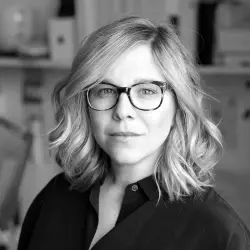Your Interview Alex Pappas-Kalber

Alex Pappas-Kalber
Product
USA
How long have you been involved in the lighting industry in total?
If you count my time in theatrical lighting at the very beginning of my career, 23 years. I’ve been a designer, an electrician, a small business owner, a university professor, and now a marketing/sales professional.
Have you always been involved in the manufacturing side or have you come from another part of the industry?
I started in theatre – as a lighting designer and electrician. Then I moved to architectural lighting design for the majority of my career upon my completion of my master’s in architectural Lighting Design. I taught at the graduate level in university, and now I’ve been in manufacturing sales for the past a year and half.
Do you feel that there is a wider diversity in sales, manufacturing and marketing over the last 20 years?
I do – I’ve seen several women designers move into sales in the last 5-10 years. However, it still feels like an industry that is segregated – inside sales and customer support is largely women; while outside sales, engineering, operations, assembly, and c-suites are largely men. Though I have worked with some bad-ass women logistics and marketing specialists!
What reasons do you think there are so few women working for manufacturing companies? What obstacles do women come up against?
Compared to the design side of the industry, manufacturing is more “corporate”. It means larger companies, often conglomerates, where there still tend to be some misogynist leftovers from older generations – sometimes via subtle undertones, sometimes blatant. There is pay inequity between men and women in this industry, and the ‘boys clubs’ still exists. I’d love to see the statistic on the percentage of male CEOs to female CEOs of lighting manufacturers – the perception is certainly that the majority of leadership positions are held by men - while on the design side the number of female principals may even outweigh the men? Another obstacle in sales is that the job requires significant travel, which can be difficult for women because we are generally the caregivers in our families – whether that be children or aging parents. I am only able to do this job because my husband shares the childcare responsibility with me, he actually does the majority of it since I’ve had this job, and that is rare. Also sales and marketing require ‘wining and dining’ of clients and customers – we’re hosting after-hours events that push alcohol consumption and that can be tricky to navigate for women. A woman salesperson from another company told me that she was known in the industry as “One and Done” because she would show up to every event, have one drink, and then leave before anyone could get sloppy. It’s important to note that the issue of drinking isn’t specific to manufacturing, its an industry-wide issue – back during my designer days I was once grabbed and kissed on the mouth without my permission by a male sales person at an industry party. Luckily, this drinking culture is starting to change – I’m seeing event organisers offering mocktails and other activities that don’t rely on drinking.
How do you think more women can be encouraged into this side of the lighting industry? What can manufactures do to encourage a diversity of applicants for roles in sales and product development for example?
I’d start with pay transparency. Then I’d provide a solid family leave policy – including parental and caregiver leave, and remote/flexible schedules. Clear policies and procedures for harassment and after-hours requirements need to be in place and there should be a dedicated and safe HR department to handle complaints. And maybe the most important one – show prospective women employees that you value and respect women enough to promote them to the leadership positions in the company! Fill your board of directors with women!
What are the positives of working for a manufacturer? What are the negatives?
The biggest positive is by far the financial aspect - higher salaries and sales commission/bonus opportunities, and exponentially better benefits like health insurance plans, retirement savings, and paid time off. Other positives I’ve experienced include a better work-life balance, with a more standardised work schedule when I’m not travelling. I’ve also found that there is more budget and infrastructure for company-sponsored professional development and continuing education.
Is there anything else you would like to add?
Our specifiers are young and progressive, and we have to find creative ways to engage them. Its not just about technical requirements or budgets anymore – specifiers want to work with sustainable, ethical companies that share their values. That’s the story here, and women have a phenomenal opportunity to tell that story and help shape the lighting manufacturing industry as we move forward.




